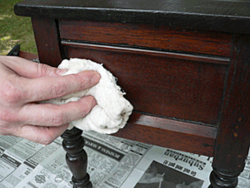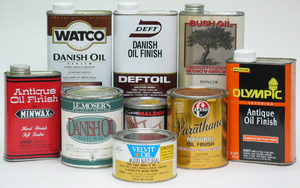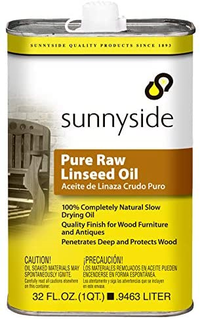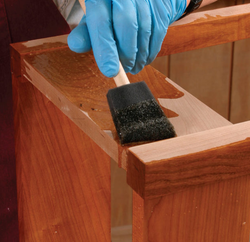Chemistry in the Workshop: Difference between revisions
| Line 201: | Line 201: | ||
=== Recipes and Usage Notes === | === Recipes and Usage Notes === | ||
Go to [[ | Go to [[Paint Recipes]] for several different recipes, how they can be used, and my experience with them (if any). | ||
==Other Finishes== | ==Other Finishes== | ||
Revision as of 16:05, 16 January 2021
I am not a chemist and CHEM101 was a long time ago. Some of the things described here are hazardous, but few are actually dangerous unless you're stupid or careless. And all of that is on you. I'm explaining what I do or have done and I've neither poisoned myself nor burned my house down. Yet. YMMV.
Chemistry is a lot of fun as the second most practical science (after physics), there is a lot of interesting things you can do with common things around the house.
For instance, wood ash. You could throw it away, most people do. But it's mostly potassium carbonate and if you mix it with water, you get sodium hydroxide (lye). And lye is useful for all kinds of things from making soap to drain cleaners. If you want to try this, you should know this is one of those potentially dangerous things I mentioned. You see potassium carbonate is extremely hydrophilic and it will happily draw that water from your skin. And, as a bonus, as the lye forms, it will start to make soap from the oils in your skin. Cool, add more water and lather up! Actually, that's going to hurt. A lot. Wear gloves.
This article is a survey of period finishes. In this case, period is pre-20th Century. During this time finishes were one of five basic types:
- wax
- oil
- varnish
- shellac
- paint
Modern chemistry has added polyurethane and catalyzed lacquer to the list of possible finishes though these could be classified as a type of varnish (more on that below). Both of these are fast drying and much harder than previous finishes. But they lack the warm and tactile feedback of earlier finishes and I rarely use them even on my modern projects (exception: table-tops).
Here we're looking at a brief overview of each finish, why, and how it works. Then we'll get into how to prepare it and use it in the workshop.
N.B: Like many of the things I write, this got completely out of hand. If you start reading and get to feeling tl;dr but want to know stuff about finishing, there is no better single source than Bob Flexner's Understanding Wood Finishing (2010). If you can wait for it, a revised 3rd edition is due in March 2021. I recommend the print version (versus the eBook); high-resolution photos are exactly what you want here.
Waxes
Waxes are among the most ancient of coating materials, predating written history. Traditionally, waxes came from either animal or vegetable sources. What's left you ask? Parafin, a petroleum by-product. In the British Isles wax is almost always beeswax.
Source and Preparation
Beeswax is secreted by bees for use in the construction of the honeycomb and is removed from the comb by melting it with heat. Beeswax tends to be soft with a low melting point of 60-65°C/140-149°F. Its properties can be modified somewhat with processing, though likely the extent of that was filtering and purification. It can be lightened with bleach and colored with pigments.
Once the New World was opened, Carnauba wax (also known as Brazil wax) became available. This was made from the Carnauba Palm tree, a native of Central and South America. It's one of the hardest natural waxes and by itself is too hard and brittle to make a good finish. However, add 15% or 20% Carnauba wax to Beeswax and you'll have a wax finish that is a lot more durable.
Application
The most basic application of wax is to rub solid wax over the surface to be finished and then burnish it to the desired sheen. The mechanical and thermal action partially melts the wax and drives it into the pores of the wood.
A less labor-intensive approach is to prepare a liquid(ish) version which can be spread more easily and then buffed out. Liquifying wax involves dissolving wax shavings in a solvent like turpentine or alcohol. To speed the process along, you can heat the mixture. However, I hope it's obvious that this can get pretty exciting given the low flash point of the solvents. I would not use an open flame.
The drawback to a wax finish is that it never cures into anything harder than the wax you put down. While it's water-resistant, it can easily be removed by mechanical action (wear) or solvents (alcohol) and must be frequently renewed.
The Score on Wax as a Finish
Advantages
- Mildly water resistant
- Moderately resistant to acids and alkali
- Does not color the finish of the wood
- Easy and quick to apply (rub on, rub off)
- Very forgiving during application
- Easy to refresh the original finish if it becomes worn or damaged
- Non-toxic and food-safe (Once the solvent has evaporated!)
Disadvantages
- Damaged by alcohol
- Must wait for the underlying finish to cure completely, or solvent in wax may damage it
Recipes and Usage Notes
Go to Wax Recipes for several different recipes, how they can be used, and my experience with them (if any).
Oils
The second oldest approach to finishing wood products is the use of oils. You can use any oil, even animal fat, though that has some obvious (and odious) drawbacks. For wood finishes, especially furniture, we prefer what are called drying oils. These are plant-based oils that polymerize (harden) when their fatty acids are exposed to oxygen. Linseed (flax), walnut, and poppy were the most popular sources of drying oils. Other types of oil (e.g., Canola oil, Mineral Oil) don't dry. They will soak into the wood and be dry to the touch, but they don't polymerize and so are easily washed off.
Linseed Oil is the most common historical oil for finishes since it is made from the seeds of flax plants (Linum usitatissimum) which were widely cultivated for linen. Although hard references are lacking, it is believed that it was being used in England as a wood finish by the Middle Ages. It is still a common wood finish today and can be purchased in most hardware and big-box stores.
While you're there, in addition to cans of "Linseed Oil", you will see cans labeled "Tung Oil" and "Danish Oil". Unfortunately, these aren't made from tongues or Danes.
Tung Oil comes to us from China where it's been used for centuries as a wood preservative for ships. It is made from the seeds of the Tung tree (Aleurites fordii) and has properties very similar to linseed oil (water-resistant, dries slowly, non-toxic in its pure form). Pure tung oil doesn't penetrate wood well and the initial coat must be thinned for a good base.
Pure Tung Oil is less stable than Linseed Oil and must be protected from sunlight before use in order for it to cure properly. It also may have a mildly disagreeable smell while it dries. It is a darker color than Linseed Oil so it's a good choice for that first coat if you are looking for that bold wood grain look. It is also less susceptible to mold that Linseed Oil
However, the Tung Oil you are likely to encounter in Home Depot is almost certainly not pure Tung Oil. It's usually a wiping varnish that's trading on the exotic-sounding name for marketing purposes. These formulations are usually vaguely equal parts Tung Oil, varnish, and a solvent with a splash of metallic driers tossed in to speed the curing process.
The Danish Oil you'll find is a wiping varnish. No pure Danes ever. It's just a combination of oil (either Tung Oil or Linseed Oil), varnish, and a solvent base with some driers. The popular WATCO brand makes their Danish Oil in several tints which is handy for repair work or coloring the wood without resorting to stain.
Neither these are bad finishes, you are just paying too much for a wiping varnish you can make yourself. We'll focus on Linseed Oil as our drying oil of choice.
Source and Preparation
As noted, Linseed oil is made from the seeds of flax plants (Linum usitatissimum) and is available in several forms.
The purest form is simply the pressed oil and it is used as a supplement and a food additive. In this case, it will usually be labeled "flaxseed oil" in your health food store or hipster market. None of the remaining forms are edible.
Raw Linseed Oil is, in theory, the same as Flaxseed Oil noted above just without the care to keep out contaminates. In practice, however, modern Raw Linseed Oil has been boiled to shorten the drying time and may or may not contain other additives. Raw Linseed Oil is typically used as a gunstock finish where a high luster is desired. It's fairly hard to find outside that market.
Stand Oil is likewise boiled Linseed Oil but has been taken further along the process and is highly viscous. It's used in artist paints since it dries clear and is less prone to yellowing over time. Something that's desirable in furniture, not so much in oil paintings.
Finally, Boiled Linseed Oil. This is what you can find everywhere. Since Linseed oil dries pretty slowly (depending on conditions, it can take from days to weeks to fully cure) it's processed to make it usable in a timeframe appropriate to a furnituremaker trying to earn a living. You can shorten the curing time by:
- heating the oil
- saturating it with oxygen
- adding "driers"* to the oil.
Often all three techniques are employed. The resulting Boiled Linseed Oil will dry in a few hours.
*Driers are lead oxide (in pre-modern times), and either zirconium, cobalt, or manganese metallic salts. These salts act as a catalyst for the oxidation process and greatly reduces the drying time.
I ended up doing a deep dive on the chemistry of Linseed Oil and you can read All About Linseed Oil.
Application
A Linseed Oil finish is built up in layers. There are several approaches to applying that first layer, but after that, it's pretty much all the same.
The first layer approaches:
- Thin the oil by 25% or more to improve the initial penetration of the wood. This is particularly important if water and rot resistance is the goal. Once the first layer cures, you won't get any further penetration of the wood, you'll just be building on that first layer.
- Flood on a heavy layer with a paintbrush. Continue adding oil for 10-30 minutes in areas where the oil soaks in and looks dry. After 30 minutes, wipe off the excess oil and allow it to dry overnight (possibly longer for this heavy coat). This is a good choice if you are impatient like me since you get a good base right away. It's also good for ring-porous woods like oak and ash which have a lot of open fibers to fill if you want a good layer of protection.
- Apply a small amount of oil to a clean cloth and apply it by rubbing along the grain. Do not starve the wood, meaning you should not have to rub hard to get the surface wet. Re-oil your rag as needed to avoid this. But also, do not over-saturate the surface either. You are looking for a wet surface but it should not have any standing puddles. After 30 minutes, rub the surface with a clean rag to remove the excess oil.
Let the project stand for at least 24 hours, or until dry. If you used #2 above, it will probably be a couple of days unless your shop is warmer than mine. Especially for oak. If you hurry it along the oil in the pores won't have cured and will weep out as you move the project around.
Subsequent coats follow #3. Thin coats will dry quicker and will build your finish faster. For utility projects, I use at least 2 coats. For stuff leaving my shop and going to other people, I apply at least 4 coats.
It may take weeks for full curing depending on conditions.
To obtain a super-smooth finished surface, rub the project surface with 0000 steel wool (or equivalent). The dust produced should be a white powder, and if you get a gummy resin instead, wait another day before proceeding. You can also do this between coats, but that seems excessive to me.
| CAUTION: the drying process of Linseed Oil is exothermic therefore rags soaked with linseed oil and dumped in a pile are a fire hazard because they provide a large surface area for rapid oxidation of the oil. The oxidation will accelerate as the temperature of the rags increases. This spiral will continue until all the oil has oxidized or you exceed the temperature dissipation rate of said rags, in which case you get a cheery blaze. In your shop. Spread out your rags to dry (on a non-flammable surface), or place them in an air-tight container, or soak them in water. |
The Score on Linseed Oil as a Finish
Advantages
- Water-resistant. However, water left on the surface may penetrate given enough time
- Flexible. Oil finishes don't crack as the wood expands and contract
- Accentuates the texture and grain of the wood
- Easy to apply
- Very forgiving during application
- Easy to re-apply if the original finish becomes worn or damaged
Disadvantages
- Linseed oil takes time to dry. Boiled linseed oil dries much faster.
- Lack of any UV inhibitors
- Linseed oil can support the growth of mildew
- Not very abrasion resistant
Recipes and Usage Notes
Go to Linseed Oil Recipes for several different recipes, how they can be used, and my experience with them (if any).
Varnish
Varnish consists of three primary ingredients:
- a resin (in the Middle Ages this was Rosin or Amber, later Copal)
- a drying oil (typically Linseed Oil)
- a solvent (usually turpentine)
As the solvent evaporates the resin solidifies and bonds to the oil polymer as it forms. The result is a clear coating that is much harder than oil alone yet remains flexible making it a near-ideal wood finish.
The oldest example of varnish yet found is on wooden mummy cases from 500 BCE Egypt. The first known description of the varnish making process is found in the eleventh-century manuscript Schedula diversarum artium by Theophilus Presbyter. The context is as a final protective finish on oil paintings.
Cennino Cennini mentions varnish in his Il Libro dell'Arte (~1400) in the same context as Theophilus. Interestingly, he includes a recipe for making paintings look like they have been varnished. Was it an expense issue or an availability issue?
It's not clear when varnish began to be used on furniture. Evidence of varnish has been found on late 16th and early 17th Century items, but that's inconclusive since it's hard to tell 200-year-old varnish on a 400-year-old item from 400-year-old varnish on a 400-year-old item.
Source and Preparation
Theophilus describes the varnish making process as dissolving powdered amber in heated linseed oil then adding turpentine.
Varnishes generally have a ratio of between two parts resin to one part linseed oil and one part resin to two parts linseed oil. In 1440 Jacobus de Thaleta described a varnish made with two parts gum of juniper (a raw pine resin) and one part linseed oil. Varnishes of these proportions allow the dry film to be polished to a high degree of sheen. Using more oil than this produces a film that dries very slowly.
Amber is only one of the naturally occurring resins to be used in varnish, though it's the only one common to North-Western Europe n the Middle Ages. Also used were: mastic, sandarac, and pine resin. Amber (30-90 Myr old fossilized pine sap) was mined or collected in the Baltic Sea region. Mastic is crystallized sap harvested from an evergreen shrub that grows throughout the Mediterranean region and sandarac is the sap from a small conifer native to the Atlas Mountains of North Africa.
Turpentine, the third component is distilled from pine sap by one of several techniques.
Application
Varnish is applied by brushing it on in a thin even coat. Varnish usually dries in hours, though depending on the composition, it could be days.
The Score on Varnish as a Finish
Advantages
- Water-resistant
- Easy to apply
- Resistant to wear
Disadvantages
- Can yellow or crackle over time
- Poor application techniques can result in bubbles or brush strokes.
Recipes and Usage Notes
Go to Varnish Recipes for several different recipes, how they can be used, and my experience with them (if any).
Shellac
Source and Preparation
Application
The Score on Shellac as a Finish
Advantages
- Water resistant
- Excellent as a primer coat, to seal and prevent the bleeding of resin or pigments, and to prevent wood stains from blotching
- Can be applied under most other finishes. Note that polyurethanes have trouble adhering properly due to natural shellac's wax content. Use de-waxed shellac in these situations
- Easy to repair
- Easy to apply (brush, rag, or spray on)
- Easy to re-apply if the original finish becomes worn or damaged
- Non-toxic and food-safe
- Cold temperature application – Unlike other finishes, shellac can be applied in cold temperatures (5 °C/40° F and below) without concern over proper drying and curing
- Non-yellowing and non-darkening as it ages
Disadvantages
- Damaged by alcohol (it dissolves the finish)
- Once mixed, shellac has a limited shelf-life of approximately 6 months.
Recipes and Usage Notes
Go to Shellac Recipes for several different recipes, how they can be used, and my experience with them (if any).
Paint
Source and Preparation
Application
The Score on Paint as a Finish
Advantages
- Mildly water resistant
Disadvantages
- Damaged by alcohol
Recipes and Usage Notes
Go to Paint Recipes for several different recipes, how they can be used, and my experience with them (if any).
Other Finishes
The following are some other finishes I have found, put here for future reference. I have not experimented with any of them (yet).
Danish Soap Finish
Yeah, really, soap. Source: Caleb James. There is also some information on Chris Schwarz's Lost Art Press Blog.
One of the most mysterious things about Danish modern furniture to me when I started making it was this strange soap finish that is talked about so often. I wondered, "What is this all about"?
Well, the easy answer is that it is a soap that is simply washed onto the wood surface. You may wonder how that protects the surface, though. Basically, soaps traditionally were made of oils of some sort or another. Your grandma or great-grandma would have used "Ivory" soap flakes that were made from vegetable-based sources, palm and coconut oils usually. Everything from clothes to who knows what was washed with it.
Why use soap to protect wood surfaces? Wood has pores and those pores will get clogged with dirt and oils from use if not protected. Soap clogs those pores and keeps the dirt and oils out. Also being soap, it also releases dirt and oils easily thus keeping them off of the surface.
Wood also benefits by having a finish that slows the exchange of moisture from the wood to the surrounding atmosphere, thus keeping it more stable. Soap finishes aid in doing this like other finishes though to a lesser degree.
The biggest advantage, I believe, is that it leaves woods like white oak and ash looking as natural as the raw wood itself. As a woodworker I love the organic feel this gives a piece. The soap finish is also incredibly smooth to the touch and ages so beautifully.
Some suggest that soap finishes are a lot of maintenance. I have found that since they age nicely I really don't do anything to maintain their appearance. If it does get soiled, simply wiping the surface with a damp cloth will usually remove whatever is unwanted. Wiping the surface with more of the same soap will freshen it up as well. In Denmark, this is often used to finish floors even. I think that attests to its durability and effectiveness as a finish. I purchase my soap flakes from a U.K. based producer. www.msodistributing.com currently can supply this in the US.
Here is how I prepare my soap finish. I mix boiling water and soap flakes in equal parts, 1/1 ratio. If I am making a large batch I will reduce the water a bit. I only want enough water to dissolve the flakes and it should create a whipped cream-like consistency when mixed together but with a thicker body to it, not so airy.
First, measure out your flakes and then pour the boiling water in equal parts over the flakes. Let that sit long enough for the flakes to absorb the water and it will get a translucent appearance and will become sort of jelly-like. Now mix in a bowl until you get the consistency I mentioned above. See the photo below.
You can now place a small amount inside a lint-free white cotton cloth that is folded over itself. Squeeze the soap through the fibers and to the outer surface. This will thoroughly saturate the cloth with soap. Now wipe it on the surface of your wood. Put on enough to fill the pores. Don't let it cake on the surface, though. Once it is dry you can knock down any raised grain with 220-320 grit sandpaper. Apply one more coat and that is usually sufficient. Finish by buffing with a soft cloth if desired.
To freshen up your finish follow the same steps. If you have a set in stain you can try pouring some boiling water on the spot. The soap will often force the stain loose. Let it dry and reapply a finish.
A note of caution; Do not wet end-grain surfaces too heavily. These areas absorb more water than the face grain and can crack if continually saturated. Thus it is best to make your soap with less water and more like a paste. Also coat both sides of a panel, such as a tabletop, evenly so that it will reduce the potential to cup or warp.
References
Sources that mention Varnish
- Heraclitus. (s. XI )."De Coloribus et Artibus Romanorum". Cap. 11-A to 44.
- Theophilus. (s. XII ). Capítulo 37.
- Leonardo Da Vinci (1452 – 1519). "Book of notes".
- Dr. Ketam’s. (2ª m. S XV ). "Flemish Manuscript".
- Anónimo alemán (1503 – 1506). "Liber Illuministrarius". Sec. 19.
- Marciana Manuscript. (1503 – 1527). Paragraph 395.
- Timoteo Rosello. (1575). "Della Summa de Secretti Universali".
- Theodore Turquet de Mayerne. (1620). "Pictoria, Sculptoria et qua Subalternum Artium". P. 43
- Chrstopher L. Morley. (1697). "Collectanea Chymica Leydensia"
- Mary P. Merrifield. "Medieval & Renaissance Treatises on the Arts of Painting".





